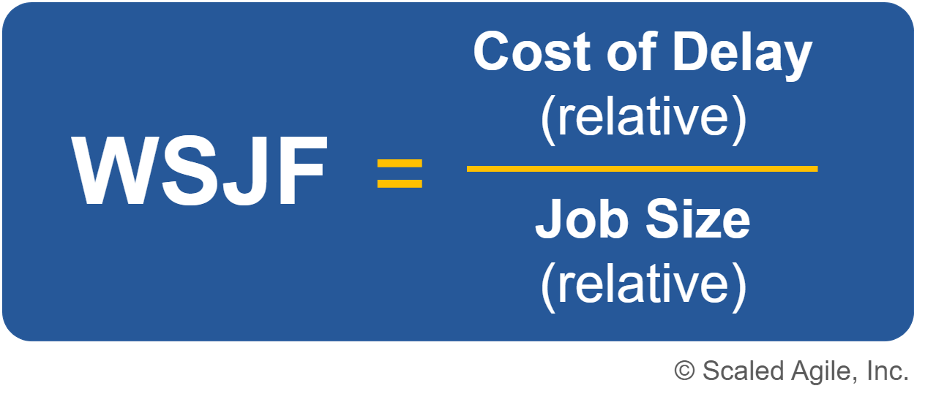Developing software is hard. And, it’s even harder to predict what people using your software will want. This has been the case for many years. Agile teams face constant challenges discerning priorities amid evolving tasks, features, and deadlines, aiming for immediate impact and lasting value. However, there is an art and a science to prioritization.. This blog post covers the vital role prioritization plays within Agile frameworks. Furthermore, it explores effective strategies and tools like Weighted Shortest Job First (WSJF) that help teams navigate the complex maze of choices. Prioritizing work effectively is vital for Agile practitioners, seasoned or new, ensuring productivity, meeting customer needs, and achieving project success. So, get ready to dive in and learn a trick or two.
What is WSJF?
WSJF, stands for Weighted Shortest Job First. It is a prioritization model used in Agile project management. Recently highlighted in the Scaled Agile Framework (SAFe), the main purpose of WSJF is to help teams prioritize work and features based on the economic value they bring. Fundamentally, it’s a method used to sequence jobs (like features, capabilities, and epics) to produce the maximum economic benefit in the shortest time possible.

The WSJF model calculates the priority of a job by dividing the Cost of Delay (CoD) by the job size or duration. The Cost of Delay is a critical component in this model and is typically a combination of three factors:
- Business Value: The direct benefit that the implementation of a feature or job will bring to the business.
- Time Criticality: This reflects the urgency of the job or feature, considering factors like deadlines, market windows, or event-driven delivery.
- Risk Reduction and/or Opportunity Enablement: This factor takes into account the degree to which a job can reduce risk or enable new opportunities.
The size or duration aspect of the equation is an estimate of how long the job will take or how large it is. This is often based on story points or team days.
Teams can objectively prioritize tasks by calculating WSJF scores, ensuring the most beneficial jobs are done first for business impact. This method proves valuable in environments with numerous crucial tasks, helping rationalize the order in which they should be addressed.
An Example of WSJF In Action
Let’s consider a real-world example of using Weighted Shortest Job First (WSJF) in a software development team within a tech company. This team is working on a new mobile app with several features in the backlog, including:
- User Login via Social Media (Feature A)
- In-app Purchases (Feature B)
- Push Notifications (Feature C)
- Dark Mode Interface (Feature D)
So, the team needs to prioritize these features. Thus, they decided to use WSJF for this purpose. Here’s how they might approach it:
Step 1: Determine the Cost of Delay (CoD) Components for Each Feature
- Business Value: The team rates each feature on a scale from 1 to 10 (10 being the highest business value). Suppose, Feature A gets 8, B gets 9, C gets 7, and D gets 5.
- Time Criticality: Given market trends and user expectations, they rate time criticality: A gets 7, B gets 8, C gets 6, and D gets 4.
- Risk Reduction/Opportunity Enablement: They assess how each feature can reduce risks or enable new opportunities: A gets 5, B gets 7, C gets 5, and D gets 3.

Step 2: Estimate the Job Size
Next, the team estimates the effort required for each feature in terms of story points or days. Let’s say A is 5 points, B is 8 points, C is 3 points, and D is 4 points.

Step 3: Calculate the WSJF Score for Each Feature
- Then, the WSJF score is calculated by adding the CoD components and dividing by the job size. For exampleFeature A, the total CoD (Business Value + Time Criticality + Opportunity Enablement) is 8 + 7 + 5 = 20. Dividing this by the job size (5 points), the WSJF score is 4.
- Similarly, the scores for B, C, and D are calculated.
Step 4: Prioritize Based on WSJF Scores
Lastly, the features are prioritized based on their WSJF scores, with higher scores being a higher priority.
In this instance, Feature B (In-app Purchases) may have the highest WSJF score suggesting it should be prioritized, offering the most economic benefit. The WSJFmethod:
- Helps the team make a data-driven decision on feature prioritization.
- Aligns their work with business goals and user needs.
How Do I Use WSJF in Jira?
- Foxly – Backlog Priority Scoring app for Jira Cloud: An app offering backlog prioritization within Jira Cloud. Furthermore, it includes a predefined WSJF method for business value, time criticality, risk reduction, and estimated size. SPK’s team has used this for our own SaaS tool development, SPK vCAD, and had great success.
- WSJF for Jira – Calculation and Sorting: This app provides functionality for calculating and sorting tasks using the WSJF method. It aids in prioritization and decision-making.
- WSJF Priority Calculator for Jira: A tool designed to apply the data-driven WSJF technique, allowing teams to prioritize tasks and projects efficiently within Jira.
- Agile Hive – WSJF Functionality for Jira: This app integrates WSJF functionality into Jira, supporting Agile practices. It helps teams prioritize work based on the WSJF model.

These apps are designed to integrate the WSJF prioritization model into Jira’s project management environment, enhancing the efficiency of Agile teams.
Your Next Steps for WSJF in Jira
The adoption of WSJF tools and software marks a significant step forward in streamlining Agile prioritization for teams. By leveraging these tools, your organization can make more informed, data-driven decisions aligning with your business goals. Furthermore, it will help you maximize economic value. However, integrating these tools into your existing systems and processes can be a complex task. This is where SPK and Associates, an Atlassian Gold Solution Partner, can help. Leverage our Agile proficiency and Atlassian product knowledge for seamless WSJF tool implementation, optimizing your team’s prioritization with efficiency. Our support ensures your workflow integrates WSJF tools seamlessly, unlocking the full benefits of efficient and effective task prioritization.
Contact SPK and Associates today to embark on a journey of enhanced productivity and smarter project management with WSJF.






